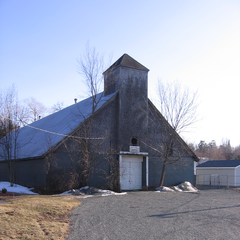Thomas Chandler Halliburton was born in Windsor in 1796. He attended Kings College in Windsor and became a lawyer, judge and politician before the Confederation of Canada.
 |
| Kings College in the early 1800's |
From there, his stories made there way to England where they were published by another person.
 |
| Painting of Halliburton House when first built |
A beautiful gramophone that had tin records. It still plays and is lovely. Also in the room was a small piano, a regular and fainting couch, a china cabinet and a table with 2 chairs. Most of the furniture is not original to the house as Judge Halliburton sold it off in 1856.
To the right of the entry way was the main parlor. It is somewhat larger than the lady's parlor and was sparsely furnished. I took no pictures of it.
Next to the main parlor was the library. It was beautiful. The desk was Judge Halliburtons and had a secret compartment.
And the light on the desk was unique.
The china cabinets were filled with old pottery some of which belonged to the Acadian.
And there was a book case filled with antique books.
Beside the book case was a prayer chair that was used by Mrs. Halliburton. No photo of it unfortunately.
Across the hall was more room that were built on starting the year after the Halliburtons moved in. One room was a gorgeous dining room. The dining room and one other room had sky lights making those room bright and airy feeling.
Beside the dining room was the judge's office. Down the hall from the office and library was the children's wing. It housed their bedrooms. On the landing these items were displayed.
It would be interesting if Mrs. Halliburton used items similar to these or not.
The bedrooms were small and 4 children slept in the bedrooms in this wing.
This larger room probably housed several of the children. There was also a long room that housed some toys but I suspect it was another bedroom.
One climbed stairs to another area that probably was for storage and then up to a look out that was added in later years. Downstairs is the kitchen.
This kitchen was not what I expected but it was extremely interesting. I did not see any place for a wood cook stove so wondered if everything was cooked on the fire and in the bread oven. Who really knows.
The many items found in the basement were to the period and quite interesting.
Spinning, weaving items interested me.
Wooden bowls .......
Glass and crockery..............
Butter churn and crock which held milk..........
Cast iron dishes and flat irons........
Dishes galore with all of them from one set.
The basement is one large room but research states it was several room due to construction.
In 1856, after his children were grown and on their own, Judge Halliburton sold his home and furniture and moved to England. There he married and lived in Gordon House until his death.
In 1939, the province of Nova Scotia bought Halliburton's house in Windsor as it is an important piece of Nova Scotia's history. There are discrepancies to the history of the house; what you are told and what has been found out is part of the charm of this place.
Hockey's Birthplace
Windsor's claims the fame to being Hockey's birthplace.It was first called hurley and was mentioned in Judge Halliburton's book.
In the house, the other end of the long hall was the adult sleeping area. The four rooms in that wing have been converted to the Hockey museum.
One of the first hockey sticks used to play hurley. The Mi'kmaq people designed hockey sticks as they look today.
And, believe it or not, the first pucks were made from wood.
The predecessor to the Stanley cup lives here. It was won three times by Moncton and that team got to keep it. The shield in the front replaced the trophy.
 |
| The Stannus Street Rink, also known as the Windsor Rink, in Windsor, Nova Scotia is a former ice hockey arena. It is considered the oldest ice hockey arena in Canada, having been built in 1897. |

Some hockey players from Nova Scotia who played NHL hockey.
One of the older hockey teams from Windsor
And a lady's team. Ladies could not play hockey for many years after hockey was founded.
We went outside so Grandson could play frisbee and we got to see a sundial which told us it was near noon.
We had a fabulous time and have two more museums to visit in the next two weeks.






































No comments:
Post a Comment